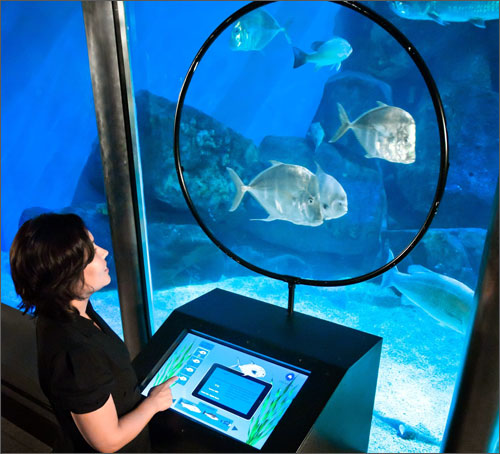Jul 13, 2011The Virginia Aquarium & Marine Science Center, located in Virginia Beach, names each fish swimming within its 45,000-gallon Chesapeake Bay tank, and records that animal's history in order to better understand the fish's health, life-span and behavior. With an RFID system now in place, however, aquarium visitors can view that same information, identifying such individuals as "Ted the black drum fish" and viewing where that particular fish was collected from the wild, its size and growth history, and its species characteristics—all displayed on a 23-inch video monitor as the fish drifts by within the tank.
The system, which went live yesterday, includes low-frequency (LF) RFID chips implanted in the fish, along with an RFID reader installed on the tank's exterior. The RFID hardware and technical assistance were provided by Oregon RFID, a Portland-based fish and wildlife tracking technology firm. Software to store and display information about each creature was developed by System Technologies Advanced Research (STAR), headquartered in Chesapeake, Va.

Jeffrey L. Mahon, the aquarium's director of exhibits and animals, has a background in radio frequency identification that began with the installation of an RFID fish-tracking system for the benefit of visitors at the Underwater World Singapore aquarium in 2007, as well as at Underwater World Pattaya, located in Pattaya Beach, Thailand, a year later. According to Mahon, the Singapore system—touted as the first RFID-enabled aquarium fish tank—increased attendance at the facility, and currently continues to operate at that location.
Oregon RFID, which provided technology for the two Asian deployments, typically sells its technology for such wildlife purposes as tracking fish migration in streams and rivers. The Texas Instruments 134.2 kHz LF tags comply with the ISO 11784 and 11785 standards, intended for reading tags through water at a range of up to 6 feet. Warren Leach, Oregon RFID's owner, says Mahon approached his company for the RFID technology required to provide data regarding fish within an aquarium environment, first in Singapore and then in Thailand. Oregon RFID provided the tags, along with its own RFID readers, which include Texas Instrument circuit boards.
In the case of the Virginia Aquarium, Mahon had a new challenge: designing a system that could read tags through salt water. The tank in question features fish typically found at the mouth of Chesapeake Bay, such as black and red drum fish and permits. The aquarium already employed LF tags implanted in some of its sharks and sea turtles, for the purpose of identification, but the existing system reads those tags only at very close range, using handheld readers in the event that an animal is removed from the tank. For the new deployment, Mahon says, the aquarium implanted chips in approximately 40 fish within its Chesapeake Bay tank, each weighing at least 3 pounds. The chips were implanted in the animal's muscle, near the dorsal fin. A 16-digit ID number on each tag was then linked to the corresponding creature's personal history, as well as information about its species, in software provided by STAR.
With the system now installed at the Virginia Aquarium, the RFID reader is attached to the tank's exterior, on an acrylic panel mounted on the tank's surface. The reader's antenna captures the ID of each fish tag that passes within about 9 inches. The read range is short, Mahon says, due to the water's salt content, though he hopes to increase that range by modifying the antenna's placement or design. One idea, he indicates, is to install the antenna inside the tank, within a piece of watertight PVC pipe. In the meantime, the aquarium has tried multiple antenna configurations. "Last week," he states, "it was circular [about 2 feet in diameter]; this week, it is rectangular [about 1 foot wide by 4 feet high]; and next week, it may be a straight vertical line."
As a fish tag is read, that tag's ID number is forwarded to the STAR software, which then displays a photograph and a description of that animal on the video screen. After the fish swims away, the information remains on the right side of the screen, while a new creature may pass and its own data will then be displayed on the center of the screen. Visitors can utilize the touch screen to select a specimen that has already swam by, and read more about it.
Mahon says he hopes to also install the system within one of the aquarium's freshwater tanks, which will provide a longer tag read range—though fish move more slowly in the freshwater tank, he notes, so data would be displayed at a slower rate as well.
"We're hoping this opens a new paradigm of signage in aquariums, and in zoos, too," Mahon says. "The goal is to get people closer to the animal, to connect with its history, and hopefully to connect with it emotionally." Although only a day had passed since the installation, Mahon says he has seen interest in the system from visitors who have viewed the RFID-based data on the screen. A second video monitor, displayed above the touch screen, describes the RFID implementation and explains how it works.


